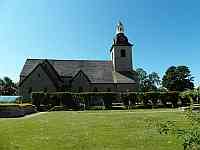
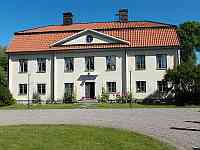

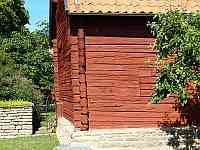
The old convent is beautiful
The manor house is rather grander than the average vicarage!
I loved the texture of these ancient planks ...
... which were just an old shed in the grounds


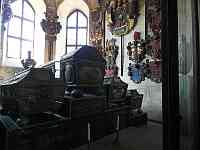
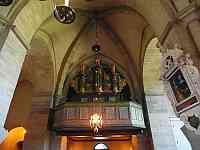
Yes I'm sure you guessed it. Although it was a lovely sunny morning, we didn't go swimming in the lake; the Swedish folk may love swimming in cold water, but it's not for us. Instead we walked up the towpath past the staircase of 7 locks, and went to see the beautiful 12th century Convent of Vreta. It really was beautiful there, not only in the wonderful gardens but also inside the amazing church with its strong UK connections (the Douglas family from Scotland have been the lords of the manor since the 17th century) and we really enjoyed our brief stay here.
When we got back to the canal the Diana had completed its ascent of the 7-lock staircase that begins the 15 locks of the Berg flight, and was waiting in the half-filled top lock. Again this was done so that we could most easily rejoin the ship, and all other traffic had to wait until we were ready to depart.
The ship's guide seemed highly excited about the aqueduct that we crossed that morning, so the other passengers became excited too; but it did not impress us much as we have a similar aqueduct just 5 miles from home, and there are several aqueducts in the UK which are far more impressive. More interesting was the "Helmsman's Horror" corner at which so many boats used to run aground that in the 19th century the house owner there built himself a summerhouse from which to watch them.
As we crossed lake Boren, 250ft above sea level, we could watch a number of small boats coming down the 5-rise staircase of locks that would continue our relentless climb. The entrance to these locks was protected by a harbour wall which made it an extremely difficult turn into the bottom lock, a feat which the captain achieved so expertly that I went up to the bridge to congratulate him; he seemed surprised and genuinely pleased that someone had noticed it.
We stopped that night at Motala, where the Gota Canal Company's offices stand. It was a beautiful evening, and some of the crew went swimming in the canal before having a grand barbeque on the bank-side. We meanwhile visited the museum there; it was a fascinating little museum, but there were so many items which I remembered from my childhood - or which we were even still using - that I wondered if I should volunteer to stay and become an exhibit.
The next morning we crossed the corner of Lake Vättern to stop at the 16th-century Vadstena fortress. We turned right into the castle's moat, using a bow-line and strapping-post to turn the ship around (it is not equipped with "modern" luxuries like a bow-thruster) and moored there for the morning. With its incredibly thick walls the castle reminded me very much of Fort Vardo on the Norway-Russia border that we had visited in 1999, although this fortress was twice as big as the Norwegian one.
After a tour of the castle we were taken through the town on a small road-train. Historically the inhabitants of the town must have been a nosy lot; many of the houses had mirrors outside the windows, angled so that someone sitting in the living-room could see everything that happened in the street without leaving their chairs!
The castle however was not the town's main feature; in the 14th-century Sweden's only female saint, St Bridget (Birgitta), founded a convent here and it became one of Sweden's foremost places of pilgrimage. Her story is intriguing; she was canonised because as a child she constantly had visions which were then found to match Biblical events remarkably precisely. After she visited the Pope personally in Rome, her canonisation conveniently ignored the facts that from early childhood she could read fluently, and also that her father had access to one of the few Bibles in Sweden at the time.
The Abbey's entrance had different styles of cross carved into the stonework, so that it could welcome pilgrims from different branches of Christianity; it was merely necessary to touch the appropriate cross upon entry. Inside, the abbey is spectacularly beautiful, with the tomb of St Bridget behind elaborately-carved screens illustrating her childhood visions.
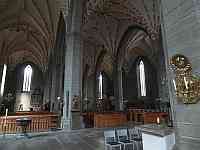 |
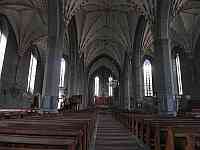 |
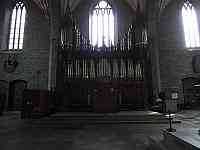 |
 |
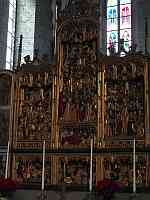 |
Leaving Vadstena we crossed the rest of Lake Vättern - almost 300ft above sea level, it is Sweden's second-largest lake - to reach the lock at Forsvig which would take us up to the canal's summit level. As we passed through the lock we were greeted by the Kindbom family who have since 1915 met every ship that passes by singing hymns, blessing the passengers and giving them bouquets of flowers.
To see and hear the Kindbom family's greeting, undaunted by the sudden rain-shower, just watch this video:
Now it was time to cross the canal summit to Lake Viken which serves as a reservoir for the canal. This is a tricky feat of navigation; first the ship must turn upstream into a flowing river section using some impressive "proper boating" techniques. As the ship passed close to the shore, the "jump-ashore Johnny" (in this case a particularly athletic crew-member whose nickname was Tarzan) leapt to the bank and ran ahead. A crew-member on the bows threw him a line with a loop on the end, which he dropped over a substantial strapping post which turned the ship part-way upstream. As the ship continued without slowing down, he lifted the line and transferred it to another post further ahead to turn a little further, and then repeated the exercise on a third post to complete the turn into the river before taking a flying leap back on board. It was wonderful to see this traditional technique being employed here to such good effect, even if most of the other passengers did not appreciate or understand it.
The route across Lake Viken is a difficult test of navigation with a maze of small islands, a narrow deep-water channel across the lake, and a narrow artificial cut which was straightened out in the 1930's in an echo of the way Telford himself straightened and shortened Brindley's Oxford Canal back in England. It is also somewhat ironic that the monument to Balthazar von Platen the original canal builder, which also marks the summit of the canal, is on the abandoned section that was cut off by this straightening.
Towards the end of that day we passed Sweden's smallest ferry, the "Lina", which provides the quickest way for the workers of Toreboda to get to their factory. It is here also that the main Gothenburg-Stockholm railway line crosses the canal; three days later we were to travel that line and take another picture from the fast-moving express train.
We stopped that night at the end of the summit pound, outside the original Canal Engineer's house, ready to begin our long descent to Gothenburg and the Baltic Sea.
All pictures on this site are © Allan Jones unless otherwise stated